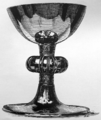Chalice (liturgy)
The chalice is a vessel that is used in the Christian liturgies (the Catholic Holy Mass , the Orthodox Divine Liturgy or the Evangelical Last Supper ) to hold the wine . The cup ( the ciborium ), which is used in the Catholic and Orthodox liturgy for the distribution and storage of consecrated hosts , also has a chalice shape .
Chalices from the first millennium sometimes have double handles. Since the 9th century, precious metals have been used almost exclusively for the chalice. Many goblets from the early Middle Ages are small-format, ornamentless grave goods for clergy.
shape

As well as the cup is the cup of the high foot dignity shape. The Carolingian examples already follow a three-part structure: A slender shaft grows out of the broad base, which is more or less centrally provided with a thickening, a knob (nodus), on which the goblet can be held easily. In the late Middle Ages, the pommel and foot were usually structured sixfold, the foot six-pass-shaped, the nodus with six round or diamond-shaped rotuli , which are provided with symbols or the letters "jhesus". The actual hollow shape, spherical or slightly conical decaying The bowl is undecorated generally, at least it has a broad, smooth left edge lip. Chalices are usually gilded on the inside, often also on the outside.
Roman rite
Before the beginning of Holy Mass , the chalice is placed on a sideboard or on the altar . The goblet includes the paten , a flat plate to match the goblet on which the celebration host is placed, the goblet and optionally a spoon with which water is added to the wine during the preparation of the gifts . The palla is placed to cover it , on top of which is the corporal , a folded linen cloth on which the chalice and the host bowl are placed during the Eucharistic celebration. In order to protect the entire structure and the chalice from external influences, the chalice is covered with a chalice veil . The chalice veil is held in the liturgical color . But it is also permissible to always use a plain white chalice velum. If a chalice velum is used, the corporal often lies on the velum in a bursa of a matching color.
In the Roman Catholic and Lutheran Churches, the wine is consecrated in a chalice during the change.
The cup of communion in Protestantism
In many places the pre-Reformation chalices continued to be used in the churches that had become Protestant. It was not uncommon for the cup (rather small in old measuring goblets) to be replaced by a larger one in order to facilitate its function as a dining goblet. In Reformed churches, simple, undecorated forms were chosen for new products. Even the dignified form of the chalice could be dispensed with in these communities in favor of a simple cup . Many goblets of Protestant churches are foundations of wealthy citizens.
Cup movement
At the beginning of the 20th century there was a goblet movement in the Protestant church (largely promoted by Friedrich Spitta ) , which propagated the introduction of individual goblets , which was initially mostly rejected by the church leaders . Above all, hygienic reasons were cited. Critics see the individual chalice movement as an expression of bourgeois, individualistic narrowing of the Lord's Supper. A specially designed pouring goblet is required to distribute the wine in individual goblets , if the individual goblets are not filled beforehand. Single goblets are usually made of stainless steel, ceramic or glass. At the end of the 20th century, plastic cups for single use came into use. Prefilled Communion Cups represent a further development .
Individual evidence
- ↑ On the material of early Christian chalices: Braun: Altargerät , p. 39; Elbern: Eucharistic Cup , p. 63.
literature
- Joseph Braun: The Christian altarpiece in its being and in its development . Olms, Hildesheim u. a. 1973 (reprint of the Munich 1932 edition).
- Viktor H. Elbern: The Eucharistic Cup in the Middle Ages . In: Journal of the German Association for Art History . No. 17 , 1963.
- Georg Stuhlfauth : Communion device. In: Real Lexicon on German Art History. Vol. I (1933), Col. 46-48; also digital: RDK Labor [2. February 2017].
- Johann Michael Fritz: The evangelical device of the Lord's Supper in Germany , Leipzig ( evangelical publishing house), 2004
Pictures of the type history of the chalice in the liturgy
Tassilo chalice (around 780).
So-called " Liudgerikelch ", Essen-Werden Abbey Church , 11th century.
Romanesque chalice from Soest, St. Patrokli Cathedral
Chalice from Klosterneuburg , 1337
Late Gothic chalice, before 1513, miniature in the Hallesches Heiltum
Baroque chalice from Rapperswil , around 1690
Neo-Gothic chalice from the Church of the Good Shepherd in Berlin-Friedrichsfelde , 1920
See also
The article provides an overview of the other altar devices












